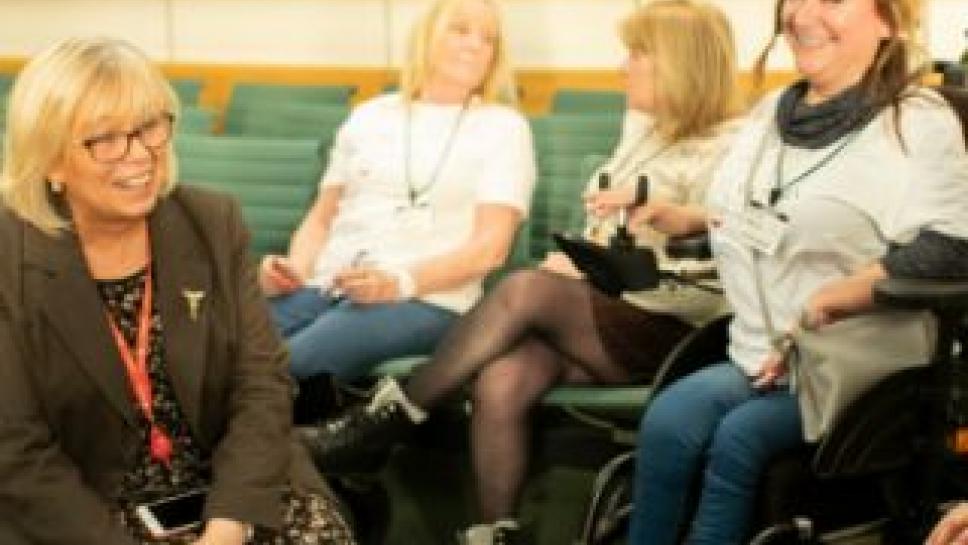
We are delighted to share this news with the SMA community. Without the support and hard work of clinicians, SMA charities, MPs and, above all, families and people with the condition, this would not have been possible. Thanks to all of us working together and our tireless campaigning, patients are facing a brighter future.
What do we know?
NICE, Biogen and NHS England say they have come to an agreement to make the treatment available for children, young people and adults with SMA Types 1, 2 and 3 through a scheme known as a Managed Access Agreement (MAA). This means that patients will be able to get Spinraza while more long-term data on its effectiveness is gathered.
NHS England says the treatment will be made available to the youngest and most severely-affected (SMA Type 1) patients immediately by Biogen, with NHS England offering funding on NICE’s publication of final guidance.
It says that for older babies, children and young adults with SMA Types 2 and 3, the NHS will begin to provide Spinraza shortly after NICE’s guidance is published, once the services to deliver them are established. This is not expected to take more than a few weeks.
You find out more by reading our FAQs on Spinraza.
What happens now?
Muscular Dystrophy UK and Spinal Muscular Atrophy UK are now calling on NICE to formally recommend the treatment and for Biogen and NHS England to urgently implement the MAA so patients can access the drug quickly, and for Wales and Northern Ireland, which generally follows NICE’s guidance, to follow suit. The charities will also continue to push for changes to the appraisal process for rare disease drugs.
In Scotland, Spinraza has been available to SMA Type 1 patients since May 2018, and this is set to be expanded to Types 2 and 3 soon under the Scottish Medicines Consortium’s new ultra-orphan pathway. Meanwhile Spinraza is available for patients with Types 2 and 3 through the Peer Approved Clinical System (PACS) Tier One system for individual requests submitted by clinicians.
Muscular Dystrophy UK will be publishing more information and reaction online and via social media as and when we have it.
Catherine Woodhead, Chief Executive of Muscular Dystrophy UK, said:
Today’s announcement is fantastic news that gives families hope. Children already receiving treatment are reaching milestones never thought possible and living longer, and now hundreds of others will be given that same chance.
Every day counts for people with SMA, and we need to ensure this decision is implemented as soon as possible, and made available UK-wide. Our work here is not done. The lengthy, frustrating delays which we have seen throughout this process must not be allowed to happen again. During this time, there will have been irreversible decline in SMA patients’ health. The appraisal system for new treatments for rare diseases needs to be urgently overhauled to make it fit for purpose for future treatments for rare conditions.
Doug Henderson, Managing Director of Spinal Muscular Atrophy UK, said:
At last the SMA community has the answer it has been asking for since NICE started its appraisal almost 17 months ago. Our thanks to NICE, NHS England and Biogen for this great news and to all the SMA community who worked so hard on this journey. The clinical evidence was there; our voices were finally heard.
We are only sorry that it took so long when time matters so much; for the families with infants with SMA Type 1 who have had no access to treatment since November 2018; for families and adults who have desperately wanted to have the opportunity to see what potential this treatment might have for them; for the clinicians who have been so frustrated by their lack of power to offer it.
We will now do all we can to support the smooth implementation of the Managed Access Agreement. We will also continue to work to advocate for change to the NICE process for appraising access to orphan medicines so that future treatments are more rapidly and appropriately assessed.”
Rachel Jamieson’s four-year-old daughter, Matilda, has SMA Type 3. This form of the condition does not affect life expectancy, but leaves children less able to stand and walk over time. Rachel, from York, said:
My heart breaks when my gorgeous, bubbly daughter Matilda asks me why she has wobbly legs, or whether her children will have SMA. Since starting school last year, Matilda has struggled more with her mobility. I believe that, if she had received Spinraza, she would not be having those difficulties.
We are over the moon that our little girl and other SMA patients will be able to access Spinraza. It could give her more independence both now and as she grows older, which means everything to us. Now, we have hope for the future
Update: Muscular Dystrophy UK and the other SMA charities are awaiting clarity from NICE and NHS England in relation to the Managed Access Agreement (MAA) and potential restrictions that we do not consider to be in line with the announcement NICE made last month. Read more about this here.
You can find out more about spinal muscular atrophy (SMA) from our factsheet.
We have an FAQs on Spinraza here.
You can read the previous news about access to Spinraza in Scotland.
If you would like information or support, please call our Information and Support Team on our free helpline: 0800 652 6352 (Mon-Fri, 8.30am-6pm) or email us at: info@musculardystrophyuk.org.
